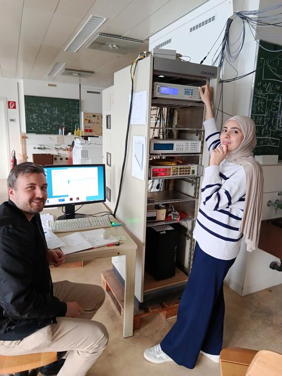Home > Press > Superconductors: Amazingly orderly disorder: A surprising effect was discovered through a collaborative effort by researchers from TU Wien and institutions in Croatia, France, Poland, Singapore, Switzerland, and the US during the investigation of a special material: the atoms are
 |
| Luka Akamović and Priyanka Reddy, researchers in Neven Bariić’s team
Credit TU Wien |
Abstract:
Superconductivity is one of the central topics in modern materials science: certain materials can conduct electrical current without any resistance at least below a certain temperature. However, how to produce materials that still exhibit this property at higher temperatures remains an unsolved problem.
Superconductors: Amazingly orderly disorder: A surprising effect was discovered through a collaborative effort by researchers from TU Wien and institutions in Croatia, France, Poland, Singapore, Switzerland, and the US during the investigation of a special material: the atoms are
Vienna, Austria | Posted on May 14th, 2025
Now, researchers at TU Wien have discovered a surprising connection between two actually quite different classes of superconductors the so-called cuprates and pnictides: the material murunskite combines properties of both in unexpected ways. The amazing thing is that even though the crucial atoms in murunskite are arranged completely randomly and irregularly, the magnetic properties are neatly ordered, even at surprisingly high temperatures, and resembles those of iron-pnictides. Analogously, in the cuprates, a particular kind of metallicity – one that might be associated only with exceptionally clean systems – emerges despite a lot of local disorder, along with the high-temperature superconductivity. The “culprits” in cuprates and murunskite are open ligand orbitals.
Two worlds and one in between
Materials that exhibit superconducting properties even at relatively high temperatures known as high-temperature superconductors normally owe this property to the complex quantum physical interaction between different types of atoms. It takes a great deal of effort to simulate the effects in such materials on a computer and understand them theoretically.
However, in recent decades, various classes of materials have been found that have proven promising for superconductivity research, such as the class of cuprates. These are ceramic compounds that contain copper atoms in which superconductivity emerges from an insulating state upon doping with charge carriers. A completely different class of superconductors are pnictides metallic materials with mobile electrons.
Researchers at TU Wien have now taken a closer look at another material: murunskite, a crystal composed of potassium, iron, copper and sulphur. Although it is not a superconductor itself, it is closely related to superconducting materials. Murunskite is, in a sense, the missing link between these two classes of materials, says Prof. Neven Bariić from the Institute of Solid State Physics at TU Wien. It has a crystal structure like pnictides, but electronic properties similar to cuprates. Its magnetic properties are novel and surprising, though reminiscent of both cuprates and pnictides.
Geometric disorder, magnetic order
There are many materials that exhibit magnetic effects. This means that the atoms align magnetically in the same way like many small compass needles all pointing in the same direction. Normally, the atoms must also be arranged geometrically in a regular manner. This is the universally accepted way to ensure that they all influence each other in the same way, so that magnetic order can develop over long distances.
Surprisingly, however, this is not the case with Murunskite: In this material, the atoms are not arranged regularly, says Priyanka Reddy. At certain points in the crystal lattice, there can be either a copper atom or an iron atom. The copper atoms have no magnetic effect, but the iron atoms do.
There is no geometric pattern according to which copper and iron atoms arrange themselves; they are completely mixed up at random. And yet, as the research team has now been able to show, magnetic order emerges at a temperature of minus 176 degrees Celsius (97K): the iron atoms align themselves magnetically in the same patterns, even though they are at different distances from each other.
In this case, we speak of emergent order, explains Davor Tolj. Even though the atoms do not follow any geometric rules, they form magnetically ordered clusters ordered islands in a sea of disordered atoms that, in a sense, agree on a common magnetic direction. These clusters network with other clusters, so that despite the lack of geometric order, a magnetic order emerges that pervades the entire crystal.
The result shows that magnetic order does not necessarily have to be based on perfect atomic order. This opens up new avenues in materials and device research, in relation to superconductors and beyond.
####
For more information, please click here
Contacts:
Media Contact
Florian Aigner
Vienna University of Technology
Office: 0043-158-801 x41027
Expert Contact
Neven Barisic
TU Wien
Office: +43 1 58801 13156
Copyright © Vienna University of Technology
If you have a comment, please Contact us.
Issuers of news releases, not 7th Wave, Inc. or Nanotechnology Now, are solely responsible for the accuracy of the content.
News and information
![]()
Onion-like nanoparticles found in aircraft exhaust May 14th, 2025
![]()
Programmable electron-induced color router array May 14th, 2025
Quantum Physics
![]()
Programmable electron-induced color router array May 14th, 2025
![]()
Lattice-driven charge density wave fluctuations far above the transition temperature in Kagome superconductor April 25th, 2025
![]()
HKU physicists uncover hidden order in the quantum world through deconfined quantum critical points April 25th, 2025
Superconductivity
![]()
Lattice-driven charge density wave fluctuations far above the transition temperature in Kagome superconductor April 25th, 2025
Magnetism/Magnons
Possible Futures
![]()
Onion-like nanoparticles found in aircraft exhaust May 14th, 2025
![]()
Programmable electron-induced color router array May 14th, 2025
![]()
Ultrafast plasmon-enhanced magnetic bit switching at the nanoscale April 25th, 2025
![]()
Next-generation drug delivery innovation! DGIST develops precision therapeutics using exosomes April 25th, 2025
Discoveries
![]()
Onion-like nanoparticles found in aircraft exhaust May 14th, 2025
![]()
Programmable electron-induced color router array May 14th, 2025
![]()
Ultrafast plasmon-enhanced magnetic bit switching at the nanoscale April 25th, 2025
![]()
Next-generation drug delivery innovation! DGIST develops precision therapeutics using exosomes April 25th, 2025
Materials/Metamaterials/Magnetoresistance
![]()
Enhancing power factor of p- and n-type single-walled carbon nanotubes April 25th, 2025
![]()
Chainmail-like material could be the future of armor: First 2D mechanically interlocked polymer exhibits exceptional flexibility and strength January 17th, 2025
![]()
FSU researchers develop new methods to generate and improve magnetism of 2D materials December 13th, 2024
Announcements
![]()
Onion-like nanoparticles found in aircraft exhaust May 14th, 2025
![]()
Programmable electron-induced color router array May 14th, 2025
![]()
Ultrafast plasmon-enhanced magnetic bit switching at the nanoscale April 25th, 2025
![]()
Next-generation drug delivery innovation! DGIST develops precision therapeutics using exosomes April 25th, 2025
Interviews/Book Reviews/Essays/Reports/Podcasts/Journals/White papers/Posters
![]()
Onion-like nanoparticles found in aircraft exhaust May 14th, 2025
![]()
Programmable electron-induced color router array May 14th, 2025
![]()
HKU physicists uncover hidden order in the quantum world through deconfined quantum critical points April 25th, 2025
![]()
Nanophotonic platform boosts efficiency of nonlinear-optical quantum teleportation April 25th, 2025
Research partnerships
![]()
HKU physicists uncover hidden order in the quantum world through deconfined quantum critical points April 25th, 2025
![]()
SMART researchers pioneer first-of-its-kind nanosensor for real-time iron detection in plants February 28th, 2025
![]()
Gene therapy relieves back pain, repairs damaged disc in mice: Study suggests nanocarriers loaded with DNA could replace opioids May 17th, 2024
![]()
Discovery points path to flash-like memory for storing qubits: Rice find could hasten development of nonvolatile quantum memory April 5th, 2024
Quantum nanoscience
![]()
Programmable electron-induced color router array May 14th, 2025










